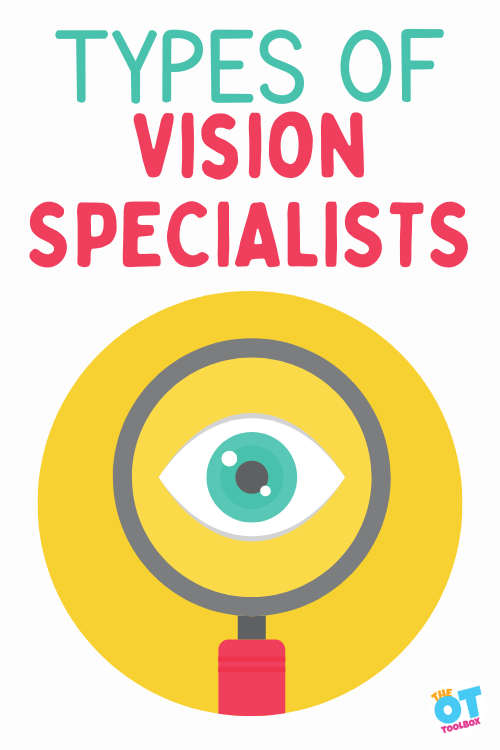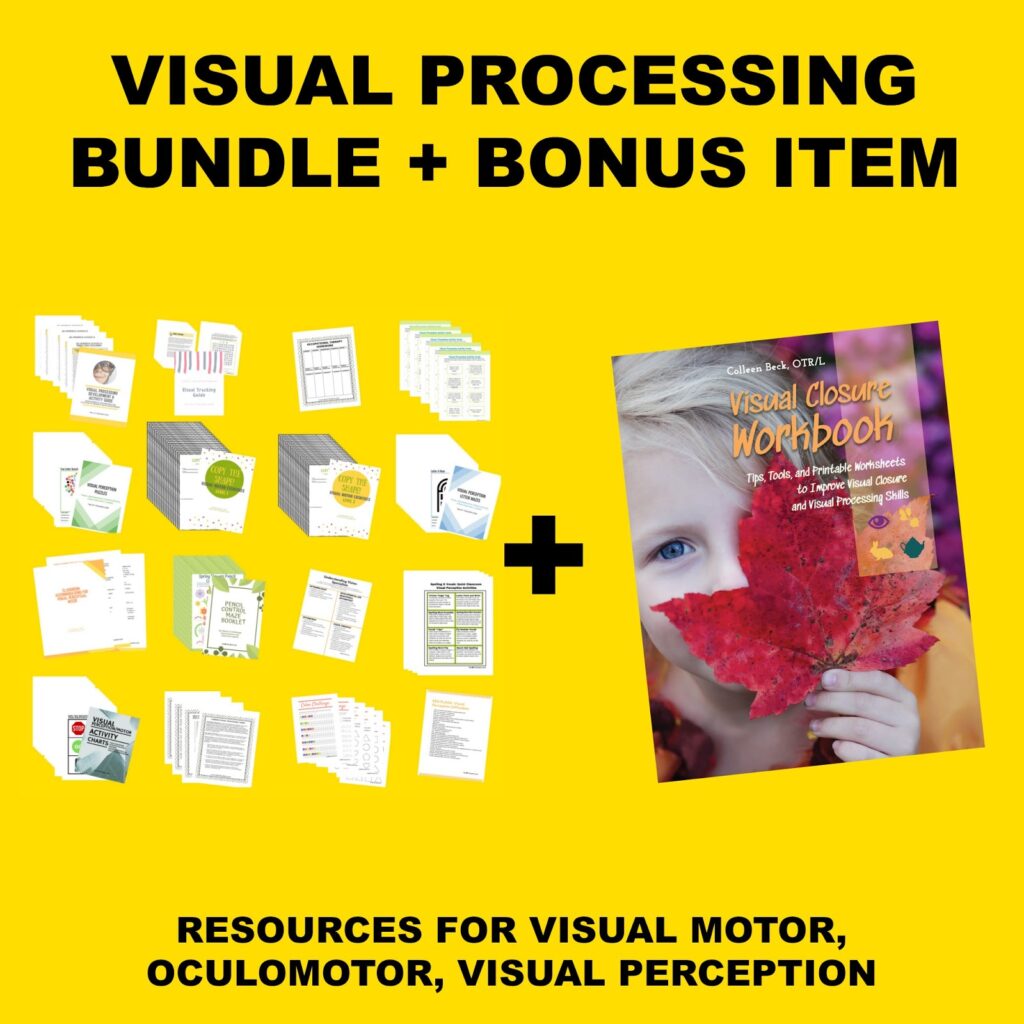In this blog post, we’re covering information on types of eye specialists. As occupational therapy providers, many times we work with clients or patients on activities of daily living or IADLS that are challenged by vision needs. Knowing about different types of vision specialists is important because we can better understand what support a the individual could benefit. Here, let’s dive into vision specialties.

If you have been researching types of eye specialists or read my post on Behavioral Optometrists, you may feel overwhelmed by all of the information out there!
In order to make this clearer, the OT Toolbox has a PDF on the Different Types of Vision Specialists. This is one of the resources included in our Visual Processing Bundle.
This post will (hopefully) shed some light on the differences between these professions, especially if caregivers are asking you for advice, or you are in the position to make recommendations after screenings*
Types of Eye Specialists
There are four different types of vision specialties highlighted on the Types of Vision Doctors/Eye Specialists chart found in the Visual Processing Bundle:
- Optometrists
- Ophthalmologists
- Behavioral/Developmental Optometrists
- Vision Therapists
The chart gives a general overview of the different roles of the four types of vision specialists:
OPTOMETRIST
- This doctor is responsible for checking visual acuity
- They can prescribe glasses and contact lenses
- Can not perform surgery and are not medical doctors
- They can monitor conditions like glaucoma, dry eye, and diabetes related vision problems
- For routine primary care, people often select an optometrist first
OPHTHALMOLOGIST
The Opthalmologist does more in depth vision care than the optometrist.
- They perform extensive eye exams, including dilation of the eyes
- They are medical doctors
- Medical eye care — for conditions like glaucoma, iritis, and chemical burns
- Surgical eye care — for trauma, crossed eyes, cataracts, glaucoma, and other problems
- Diagnosis and treatment of eye conditions related to other diseases, like diabetes or arthritis
- Plastic surgery — to raise droopy eyelids or smooth out wrinkles
According to the American Academy for Pediatric Ophthalmology and Strabismus, there are certain conditions that warrant a visit to the Ophthalmologist:
- Bulging of one or both eyes;
- Dark curtain or veil that blocks your vision;
- Decreased vision, even if temporary;
- Diabetes mellitus;
- Distorted vision;
- Double vision;
- Excess tearing;
- Eyelid abnormalities;
- Family history of eye disease;
- Halos (colored circles around lights);
- High blood pressure;
- HIV or AIDS;
- Injury to the eye;
- Loss of peripheral (side) vision;
- Misaligned eyes;
- New floaters (black “strings” or specks in the vision) and/or flashes of light;
- Pain in the eye;
- Thyroid disease-related eye problems (Graves’ disease);
- Unusual red eye.
OPTICIAN
- Opticians aren’t eye doctors and can’t give eye exams. They get a 1- or 2-year degree, certificate, or diploma.
- They fill the prescription your eye doctor gives you.
- Check lens prescriptions
- Provide, adjust, and repair glasses, frames, and contact lenses
- Take facial measurements
- Help decide which type of lenses and frames will work best
- Order and check products, including contacts and eyeglass lenses
BEHAVIORAL OPTOMETRIST
- A behavioral optometrist uses a wide array of exams to study your vision.
- Many of the tests require you to answer verbally because they’re related to how you interpret your vision.
- Because of the connection between the brain and the eyes, behavioral optometrists do measure your sight, but also your brain’s response to what you see.
- Behavioral optometry acknowledges the brain’s connection to vision, and the impacts on behavior that poor vision can have.
- They are concerned with how your eyes and visual system function, and are interested in how your behavior affects vision or how your vision influences your behavior.
- The behavioral optometrist, also known as a developmental optometrist, treats functional vision problems, including difficulties with binocular vision, eye movements and depth perception, as well as visual deficits following brain injuries.
VISION THERAPISTS
“Vision therapy” is a term used by optometrists.
- Optometrists define vision therapy as an attempt to develop or improve visual skills and abilities; improve visual comfort, ease, and visual efficiency; and change visual processing or interpretation of visual information.
- Vision therapy is often prescribed and used by optometrists or behavioral optometrists
- Many ophthalmologists advise their patients that there is no benefit to vision therapy – there is a lot of controversy surrounding the efficacy of vision therapy, however many therapists have seen success in practice.
- They work closely with the developmental or behavioral optometrist
- An optometric vision therapy program consists of supervised in-office and at home reinforcement exercises performed over weeks to months.
- In addition to exercises, lenses (“training glasses”), prisms, filters, patches, electronic targets, or balance boards may be used.
- Performs eye exercises with the goal of improving fundamental visual skills
- Works to change how a patient processes or interprets visual information
- Addresses visual problems such as lazy eye, crossed eyes, double vision, and convergence insufficiency
- According to AAPOS: Behavioral vision therapy is considered to be scientifically unproven
- American Academy for Pediatric Ophthalmology and Strabismus states there is no evidence that vision therapy delays the progression or leads to correction of myopia. They also discount the use of “training glasses”.
Vision Therapists generally address the following issues:
Oculomotor problems: Problems with eye tracking skills, including fixation, pursuits, and saccades. Fixation refers to the ability to continue looking at a stationary target. Pursuits refer to the ability to continue looking at a moving target. Saccades refer to the ability to smoothly change fixation quickly and accurately from one target to another. For example, saccades are especially important in the act of reading.
Accommodative problems: Problems relating to the focusing system of the eye. Accommodative problems include difficulties focusing accurately during close work and difficulties switching focus from distance to near efficiently.
Vergence problems: Problems with eye teaming abilities and visual convergence. An example of this is convergence insufficiency, which is when the eyes do not work well together. Convergence insufficiency is one of the most common problems that can be treated with vision therapy
There are three categories of vision therapy:
“Orthoptic vision therapy” so called by optometrists are a series of exercises usually weekly over several months performed in the optometric office. Orthoptic eye exercises (orthoptics), as used by pediatric ophthalmologists and orthoptists, are eye exercises to improve binocular function and are taught in the office and carried out at home. ”Orthoptics” is a well-established profession performed by “Orthoptists” who work within the sub-specialty of ophthalmology. Orthoptists evaluate and measure eye deviations, manage amblyopia treatment and treat small intermittent symptomatic eye deviations.
Behavioral/perceptual vision therapy – eye exercises to improve visual processing and visual perception
Vision therapy for prevention or correction of myopia (nearsightedness)
Final Thought on Vision Specialties
While much of this can be confusing, the hope is that this post with the accompanying chart defines the skills and differences between each specialist.
While some professionals do not agree with vision therapy because of lack of clinical evidence, much of what WE do as occupational therapists could be considered alternative medicine with unproven results. This holds true for chiropractors as well. We know through practice and clinical observation that what we do works, just as vision therapy can work for certain students.
Use your best clinical judgment to determine the best treatment and course of action for each of your clients.
*NOTE: Not all therapists are allowed to make recommendations or referrals. Occupational therapists do not make diagnoses, therefore we must be very cautious making referrals or labeling a condition. School based therapists are generally forbidden to make outside referrals due to liability reasons. When caregivers specifically ask for a recommendation, it is acceptable in many cases to provide a list of providers you trust. Know your district and state laws when making referrals to other types of providers.

Victoria Wood, OTR/L is a contributor to The OT Toolbox and has been providing Occupational Therapy treatment in pediatrics for more than 25 years. She has practiced in hospital settings (inpatient, outpatient, NICU, PICU), school systems, and outpatient clinics in several states. She has treated hundreds of children with various sensory processing dysfunction in the areas of behavior, gross/fine motor skills, social skills and self-care. Ms. Wood has also been a featured speaker at seminars, webinars, and school staff development training. She is the author of Seeing your Home and Community with Sensory Eyes.
The Visual Processing Bundle includes digital products to target underlying visual processing skills so you can help students with classroom tasks like copying written work, letter reversals, and messy handwriting in fun and engaging ways!
- Over 235 pages of workbooks, worksheets, e-books, handouts, activity cards, tracking tools
- Classroom accommodation ideas
- Checklists
- Multi-level visual-motor integration workbooks
- Pencil control worksheets
- Classroom and therapy activities
- Activity cards
- Specific and open-ended activity cards
- Visual tracking guide
The Visual Processing Bundle is a collection of 17 digital products. Get your copy today!







